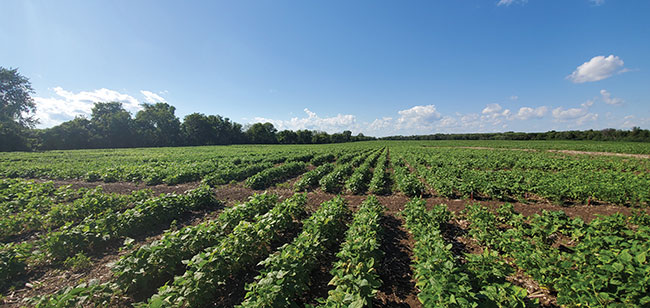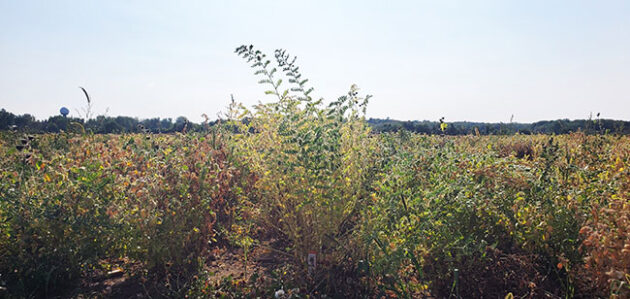
Features
Plant Breeding
Ramping up dry bean improvement
Developing new varieties for Quebec, and working to advance dry bean breeding everywhere.
October 31, 2023 By Carolyn King
 Hoyos-Villegas is breeding dry bean varieties suited to the needs of Quebec pulse growers and processors.
Photos courtesy of Valerio Hoyos-Villegas, McGill University.
Hoyos-Villegas is breeding dry bean varieties suited to the needs of Quebec pulse growers and processors.
Photos courtesy of Valerio Hoyos-Villegas, McGill University. Although only a few years old, the McGill Pulse Breeding and Genetics Lab is already on its way to developing dry bean varieties suited to Quebec needs. It is also working on innovative ways to improve efficiencies in dry bean breeding. One of its current projects involves using new tools to gain fresh insights into the bean genome and to enhance breeding resources, which could enable major breeding advances.
Heading up this lab is Valerio Hoyos-Villegas, an assistant professor in plant science at McGill University in Montreal. When he arrived at McGill in 2019, he was given the freedom to decide the focus of his research program. To figure out where to target his efforts, he started by testing a lot of pulses while examining the needs of Quebec pulse growers and processors.
“Beans were a crop that was largely underserviced in Quebec, and bean production is large enough in the province that I could make a case for working on beans. So, it was a nice fit for me to work on beans – I was very happy to get to continue working on a crop that I knew and loved,” he says.
“I also found out that there is some potential for developing chickpeas adapted to Eastern Canada. So, most of our effort is now deployed on beans, with a small but growing program in chickpeas.”
Laying the groundwork
With pulse breeding being so new to Quebec, one of Hoyos-Villegas’s first challenges was that the Quebec standards for pulse variety release had not yet been established when he started his breeding program.
So, he worked with the Comité de recommandation oléoprotéagineux du Québec (CROQ) and the Réseaux des grandes cultures du Québec (RGCQ) to develop those standards. He notes, “CROQ is a provincial committee for field crop variety recommendations, and it has oversight from the Canadian Food Inspection Agency.”
Just like the provincial standards that already exist for releasing varieties of other field crops, Quebec’s new pulse standards set out the criteria for assessing candidate varieties, such as the amount and quality of testing data needed, the required agronomic and seed quality characteristics, the specific check varieties that need to be surpassed, and so on.
Dry bean breeding program
“For Quebec crop growers, the most obvious benefit from my breeding program will be cultivars that are adapted, stable, disease-resistant and targeted at the local problems,” says Hoyos-Villegas.
“For instance, in Eastern Canada and in Quebec in particular, conditions are very wet [which increases disease risks]. Also, our growing season is shorter than, say, southern Ontario’s. So, varieties that come from other places don’t necessarily perform that well here; they often struggle to mature and finish, for example. Our program is directly addressing those needs and listening to growers and incorporating their priorities.”
He adds, “We are also listening to processors and incorporating their priorities. And hopefully that will ultimately benefit the consumer.”
His breeding program already has dry bean lines that are surpassing the checks for their market class. “We will be ready to put forward candidates for variety registration next year because by then hopefully we’ll have enough data and enough good candidates. So, for the first breeding cycle I think we are in good shape.”
Market classes
“The primary market class that we are working on is cranberry beans, because Quebec is known for marketing cranberry beans in North America and particularly in Europe,” he notes. The other market classes in his program are, in order of priority, black and navy, red and white, small red and pink, and pinto.
For all these market classes, his program focuses on improving yield, agronomic characteristics, disease resistance and grain quality.
One of the cranberry-specific traits his research group is working on is seed coat post-harvest darkening, known as after-darkening. He explains that the seed coats of beans like cranberry and pinto beans that have coloured mottling on a cream or white background tend to darken over time. That can make the beans less appealing to buyers and consumers.
Darkening is caused by exposure to light and high humidity, which causes oxidation of seed coat polyphenols; this has a degree of genetic control. According to Hoyos-Villegas, genes that prevent or even eliminate darkening have been identified and moved into pinto beans by other breeding programs. “Since cranberry beans are so important in Quebec, we want to bring that trait into the cranberry bean varieties that we develop.”
Variety-specific management
Hoyos-Villegas’s program also includes agronomic trials. “We want to look at the genotype by environment interactions for agronomic conditions and characteristics like yield and grain quality, including canning quality.” His group is doing this work in collaboration with Nortera Foods, which helps with things like the canning quality testing.
In this ongoing agronomic evaluation, his group grows different dry bean varieties and advanced lines, and compares the effects of different row spacings and plant densities, in both conventional and organic management systems. Then, canning evaluations add an extra layer of information about the stability of canning quality of candidate varieties in respect to the agronomic configuration and management system.
“[These trials] will provide more robust information for growers to make their decisions on variety selection. They’ll know which variety tends to do better under the management system, row spacing and plant density practices they use on their own farm,” he says.

Hoyos-Villegas also leads a small but growing chickpea breeding program.
Higher efficiencies, faster advances
“In breeding, we measure progress in terms of genetic gain per breeding cycle. That fluctuates depending on how many resources you have and how efficient you are,” notes Hoyos-Villegas.
As a result, his group has a keen interest in developing tools and protocols for improving efficiencies in the lab’s breeding program and in dry bean breeding programs in general.
For example, they are working with McGill’s recently acquired automated systems for rapidly measuring plant characteristics in field and greenhouse trials – measurements which would otherwise be time-consuming and labour-intensive.
Another example is research led by Hoyos-Villegas to develop protocols for automating the preparatory steps used for screening elite breeding materials using a special type of DNA marker assay called KASP. Automating and reducing the cost of these time-consuming steps could be really helpful when breeders need to screen very large numbers of samples. His group has tested this automated approach when screening dry beans for resistance to anthracnose, a common fungal disease.
Yet another example is research conducted by his group involving computer simulations to evaluate different breeding scenarios for common bean. The idea was to identify which practices would maximize genetic gain.
The simulations encompassed the type of trait, the size of the parental population, the selection strategy, the breeding framework and other factors. The results showed that all of these factors influenced the amount of genetic gain, with the optimal choices depending on the type of trait. Interestingly, the new breeding frameworks included in this study – speed-breeding and genomic selection – were not better than conventional breeding in every scenario.
Unlocking the bean genome
Hoyos-Villegas also has more fundamental interests in genomics. In a project funded by the Alberta Pulse Growers (APG) and Results Driven Agriculture Research (RDAR), he is aiming to build on knowledge about the behaviour of mutations in genomes. This project is exploring how eliminating such mutations or changing their functionality would affect genetic diversity in dry bean. Wide genetic diversity in a crop’s germplasm pool is vitally important to enable the crop to adapt to emerging threats.
“One of the greatest concerns of breeders is to prevent genetic bottlenecks, because that is effectively the end of a breeding program,” he says. “So, we want to come up with ways to maintain the elite pool of individuals while also maintaining or generating variability, which is a hard thing to do generally.”
In this project, Hoyos-Villegas and his group are using a tool called a multi-parent advanced generation inter-cross (MAGIC) population. Creating a MAGIC population requires multiple combinations of crosses, with the different crosses configured in very specific ways. With all that recombination, the resulting population has an increased level of genotypic diversity and can have some unusual combinations of gene variants, which serve as a model to study mutation.
Such a population can also be used for examining the genetic architecture of a plant species’ traits and for mapping the genomic location of those traits. As well, the different lines in the population with their diverse combinations of different gene variants make very useful breeding populations to use in developing varieties.
Hoyos-Villegas and his group used a set of black bean cultivars as parents for their MAGIC population, and they recently finished building this “black MAGIC” population. They are now multiplying the seed of their advanced inter-crossed lines for use in their research and as breeding resources.
“The first year of the advanced lines are in the field this year,” he says. “And next year we’ll have enough seed to start doing some replicated tests and collect more data here and in Alberta in collaboration with Dr. Parthiba Balasubramanian from Agriculture and Agri-Food Canada (AAFC).”
Hoyos-Villegas explains that the bean genome includes some portions that are highly conserved, meaning that they have remained basically unchanged going far back in time. The multiple recombinations in the black MAGIC population may include some new recombinations, which could allow breeders to better understand and tap into the genetic resources in those highly conserved areas.
“At the very least, we will have generated new variability in black bean germplasm pool. So that is one deliverable from this project,” he says.
“But if we are successful, the greater deliverable will be the insight into the areas of recombination of the bean genome that are traditionally hard to characterize and hard to induce recombinant genetic variation.”
If the MAGIC population generates enough information, Hoyos-Villegas’s group could develop models to track whether different mutations are gained or lost and what their effect is over time. Having that type of information could enable breeders to purge out harmful mutations and select for beneficial mutations, while still sustaining the genetic variability needed for long-term breeding success.
Supporters of Hoyos-Villegas’s program include local industry such as Nortera Foods and Haribec, as well as McGill’s Faculty of Agricultural and Environmental Sciences, Ministè re de l’Agriculture, des Pêcheries et de l’Alimentation du Québec (MAPAQ), AAFC, Natural Sciences and Engineering Research Council (NSERC), Fonds de recherche du Québec – Nature et technologies (FRQNT), APG, RDAR, Producteurs de grains du Québec (PGQ), and Mitacs. If you wish to know more about Hoyos-Villegas’s program, visit his lab’s website at pulsebreeding.ca.